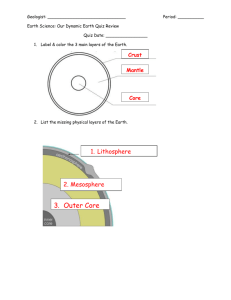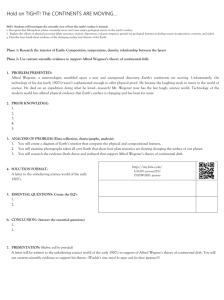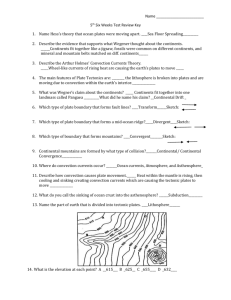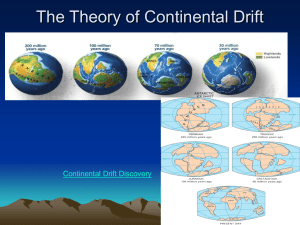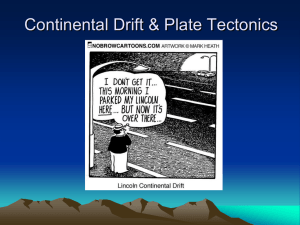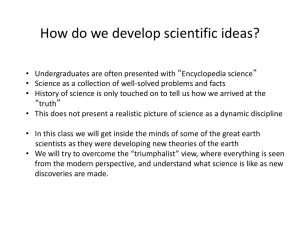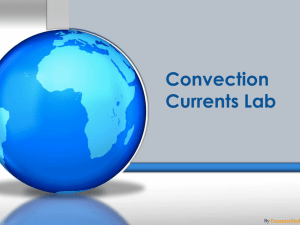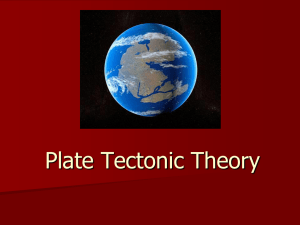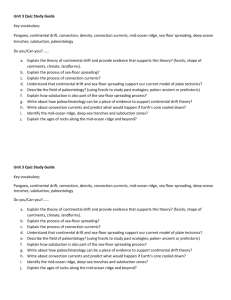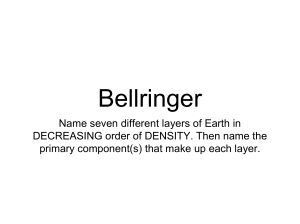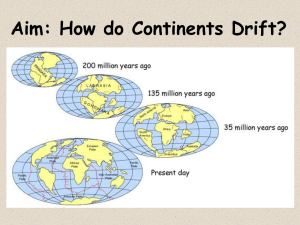Ossana plate tectonics
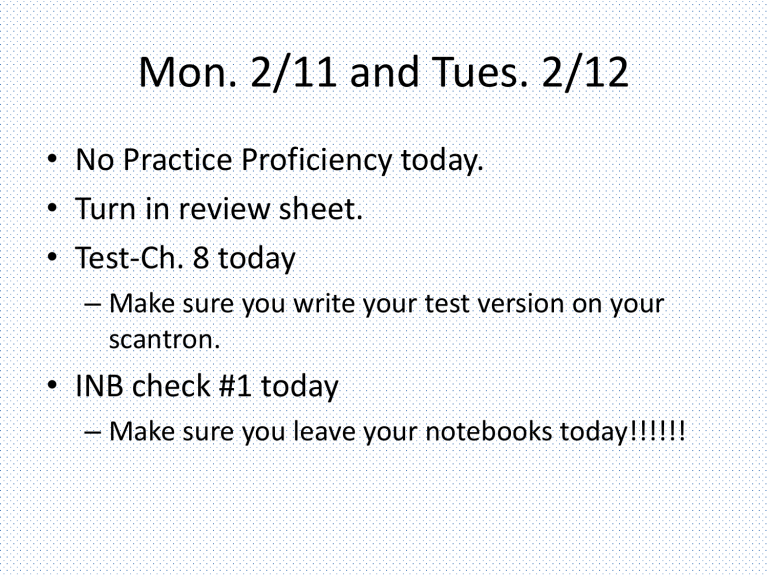
Mon. 2/11 and Tues. 2/12
• No Practice Proficiency today.
• Turn in review sheet.
• Test-Ch. 8 today
– Make sure you write your test version on your scantron.
• INB check #1 today
– Make sure you leave your notebooks today!!!!!!
• A polished mineral that is rare is called a what?
• A. Silicate
• B. Crystal
• C. Gem
• D. Ion
• 21. The greatest amount of damage from an earthquake will occur at the
• a. focus.
• b. epicenter.
c. seismograph.
d. edges of the seismic zone.
Pg. 24
Chapter 10 Plate Tectonics Overview
1. What is the title of section 1?
2. List all of the objectives for section 1.
3. What is the title of section2?
4. List all of the objectives for section 2.
5. What is the title of section 3?
6. List all of the objectives for section 3.
Pg. 25
Title Page for chapter 10
• Chapter number and chapter title.
• 3 pictures having to do with the chapter
• 3 keywords
• 3 colors
Wed. 2/13 and Thurs. 2/14
• Pick up your notebooks from the side counter.
• If you were absent last class, you missed a test and need to leave your INB with the teacher to be graded.
How are scientists able to study the composition and size of the interior layers of the Earth?
a. By direct observation b. By analyzing surface rock samples c. By using seismic waves d. By deep drilling into the interior layers
In: pg 26
• Watch the movie clip “ The Earth’s Interior” and write down 5 facts(7 minutes).
1.
2.
3.
4.
5.
Thru 1: Pg 27
The Earth’s Interior Questions
• Read the front and complete the questions on the back.
• Tape in as a flap
Pg. 28 blank
Pg. 29
Subsurface Changes on
Earth Worksheet
• Homework if not completed in class.
Out
Fill in the blank with: increase, decrease or stays the same
• As we go deeper into the Earth, the temperature __________, pressure
___________ and density_________.
Fri. 2/15 and Wed. 2/20
• Which statement BEST describes how new scientific views become accepted?
a) A group of scientists come to common agreement over an idea at the same time.
b) New ideas become a theory when hypotheses are proven to be correct.
c) When a theory gains so much support it becomes a scientific law.
d) When observations of our natural world produce plausible explanations.
• Fossils of the dinosaur,
Cryolophosaurus were
In: pg 30 discovered in Antarctica in
1991. In the picture, is the environment that the dinosaur lived in.
• How do you explain the difference between the
Antarctic of the past and of the present?
Antarctic of today
Thru 1: pg. 31
Please copy this concept map and then complete it by filling in one appropriate descriptor at the end of each arrow. Use pages
239-241 in the textbook.
When discovered
Scientist Definition
Theory of
Continental
Drift
What is missing?
Continents Fossils
Supporting Evidence
Rock
Formations
Climatic
Evidence of Continental Drift
Thru 2
Pg. 32-use the supercontinent on pg. 33 to answer these questions.
Pg. 33
Supercontinent Cutout.
Analysis Questions:
1. What are 3 pieces of evidence you used to fit together the continents?
Cutout the continents and fit them together to make the supercontinent that Wegener proposed. Glue them on this page.
2. Why is this called a supercontinent?
3. How does this model help support the Theory of Continental Drift?
4. Why aren’t the continents still in this location today?
Out
In Wegener’s time, his theory was ridiculed.
Why do you think that many scientists initially rejected the idea of continental drift?
Thurs. 2/21 and Fri. 2/22
• Prior to Alfred Wegener’s theory of continental drift geologists thought continents were fixed in their locations. In developing his theory which of the following evidence was NOT used by
Wegener?
a) Fossil similarities between southern continents.
b) Evidence of polarity change in found along the Mid-
Atlantic Ridge.
c) Similarities in the paleoclimates of South America and Africa.
d) The apparent fact the South America and Africa seemed to fit together.
In: Pg 34
As you travel towards the center of the Earth, the temperature increases because of heat generated by the core.
Before reading:
What makes the heat at the Earth’s core?
Why is the core so hot?
• It's a combination of radioactivity (the radioactive materials in the Earth generate heat) and the residual heat from the formation of the Earth. When all of the matter that created the Earth fell together, it picked up kinetic energy falling in. When it stopped at the proto-Earth, the kinetic energy was turned into heat. The Earth hasn't cooled yet. But, the vast majority of the heat in Earth's interior—up to 90 percent—is fueled by the decaying of radioactive isotopes like Potassium 40, Uranium 238, 235, and
Thorium 232 contained within the mantle. These isotopes radiate heat as they shed excess energy and move toward stability. "The amount of heat caused by this radiation is almost the same as the total heat measured emanating from the Earth."
Read more at: http://phys.org/news62952904.html#jCp
After reading:
What makes the heat at the Earth’s core?
Ch. 10 Plate Tectonics
Thru 1: pg 35
Cornell Notes
The Layers of the Earth
© Copyright 2006. M. J. Krech. All rights reserved.
The Lithospheric Plates
The crust of the Earth is broken into many pieces called plates . The plates "float" on the soft, semi-rigid
asthenosphere.
The Asthenosphere
The asthenosphere is the semi-rigid part of the middle mantle that flows like hot asphalt under a heavy weight.
Convection Currents
The middle mantle "flows" because of convection currents. Convection currents are caused by the very hot material at the deepest part of the mantle rising, then cooling and sinking again --repeating this cycle over and over.
Convection Currents
The next time you heat anything like soup or water in a pan you can watch the convection currents move in the liquid. When the convection currents flow in the asthenosphere they also move the crust. The crust gets a free ride with these currents, like the cork in this illustration.
Thru 2: pgs. 36 and 37
Pg. 36
3 Column Vocab
1. Continental Drift
2. Midocean Ridge
3. Sea floor spreading
4. Plate Tectonics
5. Asthenosphere
6. Lithosphere
Pg. 37
7. Subduction zone
8. Convection cell
9. Rifting
10. Supercontinent cycle
11. Pangaea
12. Panthalassa
Out
Tent Paragraph-use the following words correctly in a paragraph. Highlight the words within the paragraph.
• Plate tectonics
• Lithosphere
• Asthenosphere
• Convection cell
